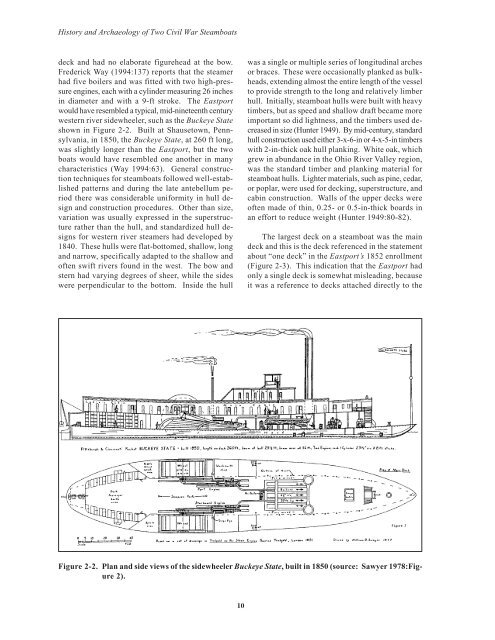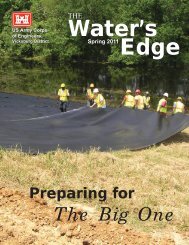history of the uss eastport - Vicksburg District - U.S. Army
history of the uss eastport - Vicksburg District - U.S. Army
history of the uss eastport - Vicksburg District - U.S. Army
Create successful ePaper yourself
Turn your PDF publications into a flip-book with our unique Google optimized e-Paper software.
History and Archaeology <strong>of</strong> Two Civil War Steamboats<br />
deck and had no elaborate figurehead at <strong>the</strong> bow.<br />
Frederick Way (1994:137) reports that <strong>the</strong> steamer<br />
had five boilers and was fitted with two high-pressure<br />
engines, each with a cylinder measuring 26 inches<br />
in diameter and with a 9-ft stroke. The Eastport<br />
would have resembled a typical, mid-nineteenth century<br />
western river sidewheeler, such as <strong>the</strong> Buckeye State<br />
shown in Figure 2-2. Built at Shausetown, Pennsylvania,<br />
in 1850, <strong>the</strong> Buckeye State, at 260 ft long,<br />
was slightly longer than <strong>the</strong> Eastport, but <strong>the</strong> two<br />
boats would have resembled one ano<strong>the</strong>r in many<br />
characteristics (Way 1994:63). General construction<br />
techniques for steamboats followed well-established<br />
patterns and during <strong>the</strong> late antebellum period<br />
<strong>the</strong>re was considerable uniformity in hull design<br />
and construction procedures. O<strong>the</strong>r than size,<br />
variation was usually expressed in <strong>the</strong> superstructure<br />
ra<strong>the</strong>r than <strong>the</strong> hull, and standardized hull designs<br />
for western river steamers had developed by<br />
1840. These hulls were flat-bottomed, shallow, long<br />
and narrow, specifically adapted to <strong>the</strong> shallow and<br />
<strong>of</strong>ten swift rivers found in <strong>the</strong> west. The bow and<br />
stern had varying degrees <strong>of</strong> sheer, while <strong>the</strong> sides<br />
were perpendicular to <strong>the</strong> bottom. Inside <strong>the</strong> hull<br />
10<br />
was a single or multiple series <strong>of</strong> longitudinal arches<br />
or braces. These were occasionally planked as bulkheads,<br />
extending almost <strong>the</strong> entire length <strong>of</strong> <strong>the</strong> vessel<br />
to provide strength to <strong>the</strong> long and relatively limber<br />
hull. Initially, steamboat hulls were built with heavy<br />
timbers, but as speed and shallow draft became more<br />
important so did lightness, and <strong>the</strong> timbers used decreased<br />
in size (Hunter 1949). By mid-century, standard<br />
hull construction used ei<strong>the</strong>r 3-x-6-in or 4-x-5-in timbers<br />
with 2-in-thick oak hull planking. White oak, which<br />
grew in abundance in <strong>the</strong> Ohio River Valley region,<br />
was <strong>the</strong> standard timber and planking material for<br />
steamboat hulls. Lighter materials, such as pine, cedar,<br />
or poplar, were used for decking, superstructure, and<br />
cabin construction. Walls <strong>of</strong> <strong>the</strong> upper decks were<br />
<strong>of</strong>ten made <strong>of</strong> thin, 0.25- or 0.5-in-thick boards in<br />
an effort to reduce weight (Hunter 1949:80-82).<br />
The largest deck on a steamboat was <strong>the</strong> main<br />
deck and this is <strong>the</strong> deck referenced in <strong>the</strong> statement<br />
about “one deck” in <strong>the</strong> Eastport’s 1852 enrollment<br />
(Figure 2-3). This indication that <strong>the</strong> Eastport had<br />
only a single deck is somewhat misleading, because<br />
it was a reference to decks attached directly to <strong>the</strong><br />
Figure 2-2. Plan and side views <strong>of</strong> <strong>the</strong> sidewheeler Buckeye State, built in 1850 (source: Sawyer 1978:Figure<br />
2).





